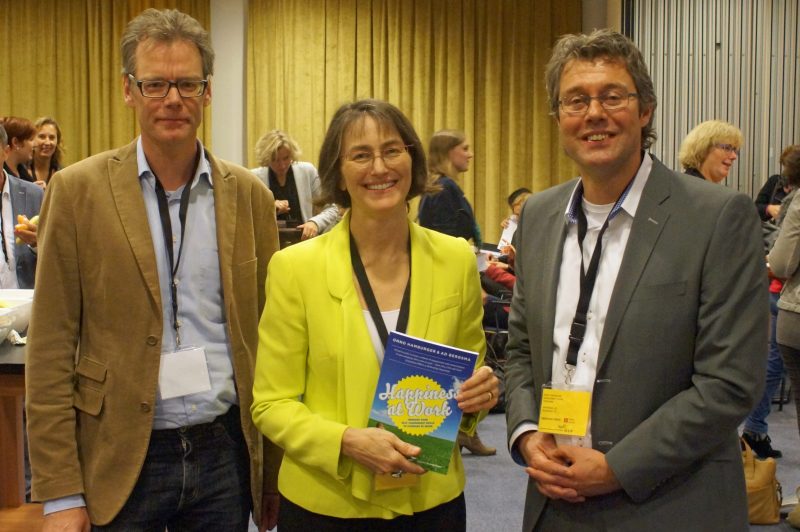When you start talking about happiness at work some people get strange ideas. Some might think you are talking about a Steve Ballmer kind of attitude. While talking about happiness at work is getting more common it is about time to address and debunk a number of common misconceptions about happiness at work. We will address 7 over here.

7 myths of happiness at work debunked
Myth 1: For you to be happy, everything must be perfect.
Some people believe that happiness at work means the eradication of all negative feelings. These people are heading for disappointment. Happiness at work means that the balance is tipped in favor of the positive and that you have the feeling that you are doing something worthwhile. However, even when things are going well, we sometimes need negative feelings, as they serve as a warning when there is a chance that things may go wrong. Negative emotions also help bring about change. The problem arises when you get stuck in these negative emotions, as the feeling of powerlessness that it brings is very unhealthy. The increase in stress and burn-out over the past 20 years shows that this is a significant problem.
Myth 2: Happiness encourages laziness.
Happy employees are not lazy pleasure-seekers: they are more active, more committed and more result-oriented. Studies show that on average, happy employees are 50% more motivated, more than twice as committed and are 30% more productive than unhappy employees.
Myth 3: Happiness cannot be measured.
It is often claimed that happiness is a personal thing that is impossible to measure. However, studies conducted over the past 30 years have shown that individual happiness certainly can be gauged. Using specially developed questionnaires, people can quite reliably indicate how happy they are. Happiness is therefore a perfectly measurable factor.
Myth 4: Happiness at work is the same as job satisfaction.
Although these two terms are closely related, there is a critical difference in usage. Job satisfaction is often a factor that is influenced by the organization, which creates circumstances that promote employee satisfaction. Happiness at work is a factor for which employees themselves are principally responsible. Studies show that while there is very little correlation between job satisfaction and productivity, there is clearly a positive correlation between happiness at work and productivity.
Myth 5: Happiness at work and happiness in your personal life are two separate things.
Happiness at work cannot be separated from happiness in your life as a whole. The disadvantage of this is that unemployment clearly has a negative effect on people’s general happiness. However, the advantage of this is that people who are happy at work are clearly happier in their lives in general. When you derive enjoyment, fulfillment and meaning from your work, this clearly has a positive effect on your general level of happiness. And vice versa, of course.
Myth 6: Happiness at work is only for highly educated people.
Some people think that philosophizing about happiness at work is only for intellectuals. However, nothing could be further from the truth. At every educational level you will find a comparable percentage of people who put their heart and soul into their work, while another percentage of the same group are simply there for the money. The more autonomy a person has, the happier they are. On average, managers and people who are self-employed feel happier. However, there are also ways to increase your autonomy without switching jobs.
Myth 7: Happiness at work is guaranteed if you have an enjoyable job.
The converse of this myth is that it is impossible to be happy if you have a boring job, which is equally untrue. The working environment is not the most important factor influencing your happiness. How you think and act is much more important. It determines the level of enjoyment, fulfillment and meaning you derive from both your work and your life, and it is completely independent of your particular working environment.
As more and more people (and organizations) are getting interested in happiness at work it is getting more important to have a good idea of what happiness at work is (and isn’t). In this post we focused on popular misconceptions about happiness at work. If you come across other myths about happiness at work please leave a comment or send us an email.
If you want to know more about happiness at work you can also take a look at our book. If you would like to get connected please “like” our Facebook page. We would love to stay connected!








 Albert Ellis, would have been one hundred years old today. He invented ‘Rational Emotive Behaviour Therapy’. Seven years ago he died in New York. Had he lived, today I would whole heartedly celebrate his hundredth birthday. Please find a short summary of his biography below. For an extended overview of his life, see:
Albert Ellis, would have been one hundred years old today. He invented ‘Rational Emotive Behaviour Therapy’. Seven years ago he died in New York. Had he lived, today I would whole heartedly celebrate his hundredth birthday. Please find a short summary of his biography below. For an extended overview of his life, see: